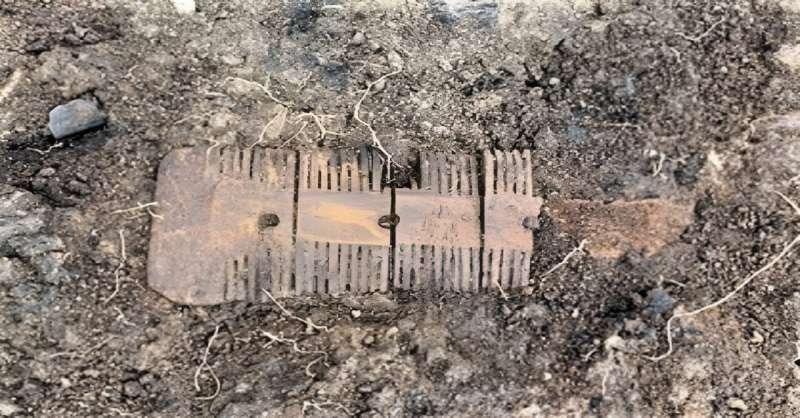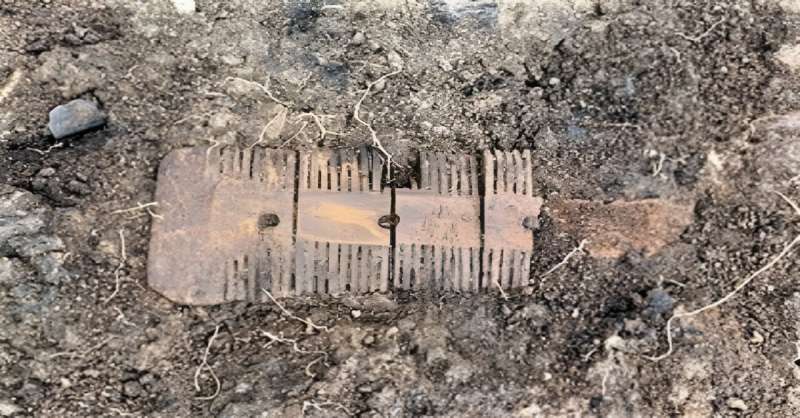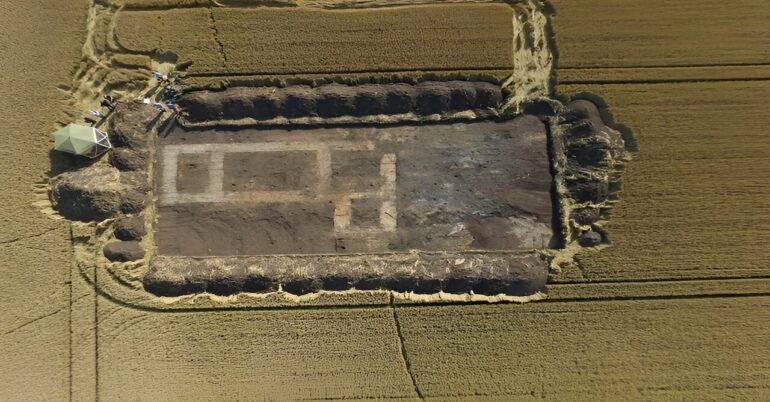Archaeologists from Newcastle University have unearthed evidence for an evolving sacred landscape spanning centuries in Crowland, Lincolnshire. The study is published in the Journal of Field Archaeology.
Crowland today is dominated by the ruins of its medieval abbey. However, local tradition holds that the area was the site of an Anglo-Saxon hermitage belonging to Saint Guthlac, who died in the year 714 and was famed for his life of solitude, having given up a life of riches as the son of a nobleman.
When his uncorrupted body was discovered 12 months after his death, Guthlac was venerated by a small monastic community dedicated to his memory. Guthlac’s popularity while he was alive, and the success of this cult and the pilgrimage it inspired, were key factors in the establishment of Crowland Abbey in the 10th century to honor the saint.
Early historical sources for Guthlac’s life exist, mainly through the Vita Sancti Guthlaci (Life of Saint Guthlac) written shortly after his death by a monk called Felix. Although there is little other evidence about his life, it was believed that Guthlac created his hermitage from a previously plundered barrow, or burial mound.
For years, archaeologists have tried to find its location, and while Anchor Church Field was widely held to be the most likely site, the lack of excavation and the increasing impact of agricultural activity in the area have prevented a comprehensive understanding of the area.
The team, which also included experts from the University of Sheffield, excavated Anchor Church Field and, to their surprise, found a much more complex and older history than they expected.
The first discovery they made was a previously unknown Late Neolithic or early Bronze Age henge, a type of circular earthwork and one of the largest ever discovered in eastern England.

One of the bone combs discovered at Crowland. © The Anchor Church Field project
Prominent site
Because of its size and location, the henge would have been a prominent place in the region and provided a major site for ceremonial activity. At this time, Crowland would have been a peninsula surrounded on three sides by water and marshes, and the henge was situated on a distinctive and highly visible point projecting out into the Fens.
The henge seems then to have been deserted, perhaps for many centuries, but the significance already given to the site by the substantial prehistoric earthworks—which would have still been visible into the medieval period—meant it was probably seen by hermits like Guthlac as a unique landscape with a long and sacred past.
It was around Guthlac’s lifetime that the henge was reoccupied, and the excavation found large quantities of material including pottery, two bone combs, and fragments of glass from a high-status drinking vessel. Frustratingly for the excavation team, all of the structures of this date seem to have been destroyed through later activity, and these artifacts offer only a tantalizing insight into how the henge was being used in the Anglo-Saxon period.
“We know that many prehistoric monuments were reused by the Anglo-Saxons, but to find a henge—especially one that was previously unknown—occupied in this way is really quite rare,” said Dr. Duncan Wright, Lecturer in Medieval Archaeology at Newcastle University.
“Although the Anglo-Saxon objects we found cannot be linked with Guthlac with any certainty, the use of the site around this time and later in the medieval period adds weight to the idea that Crowland was a sacred space at different times over millennia.”
By far the most prominent features found during the excavations were the remains of a 12th-century hall and chapel, built by the Abbots of Crowland probably to venerate the hermits here. The hall would have been used for elite accommodation, perhaps for high-status pilgrims who were visiting Crowland.
Although most of the stone from these buildings was robbed in the 19th century, documents suggest that the chapel on the site was dedicated to St Pega, Guthlac’s sister, who was herself an important hermit in the region. These same sources describe the chapel as lying in ruins by the 15th century, and it is possible that the site began to lose popularity as interest in pilgrimage waned around the Reformation.

One of the bone combs discovered at Crowland. © The Anchor Church Field project
Special place for veneration
Directly in front of the hall and chapel, the archaeologists also found a one-meter stone-lined pit that was thought to be a well when it was uncovered in the 19th century. In light of what the archaeologists now know about the site from the excavations, they think this pit could be more accurately thought of as a flag post hole or, more likely, the setting for a large cross.
After the 12th century, draining of the marshland surrounding Crowland began, transforming the topography of the area. No longer surrounded by water, the Anchor Church Field was now instead on land that could be plowed and farmed. Agricultural activity intensified from this period, and although the hall seems to have lasted longer than the chapel, it too lost its high-status function over the centuries.
Despite this change in use, the site retained its sacred history until relatively recently: 18th century documents record that the owner of the cottage, built on the site from the remains of the hall, continued to venerate the hermits, going into his back garden every Sunday to kneel and offer prayers.
“By examining the archaeological evidence we uncovered and looking at historic texts, it’s clear that even in later years Anchor Church Field continued to be seen as a special place worthy of veneration,” said Dr. Hugh Willmott from the University of Sheffield.
“Guthlac and Pega were very important figures in the early Christian history of England, so it is hugely exciting that we’ve been able to determine the chronology of what is clearly a historically significant site.”
More information:
Duncan W. Wright et al, Sacred Landscapes and Deep Time: Mobility, Memory, and Monasticism on Crowland, Journal of Field Archaeology (2024). DOI: 10.1080/00934690.2024.2332853
Provided by
Newcastle University
Citation:
Prehistoric henge reveals centuries-old sacred site in Lincolnshire (2024, April 5)



